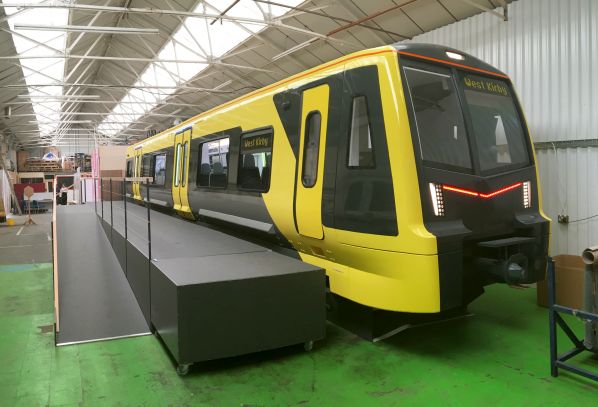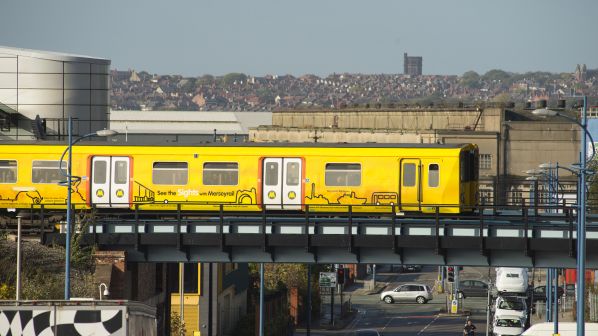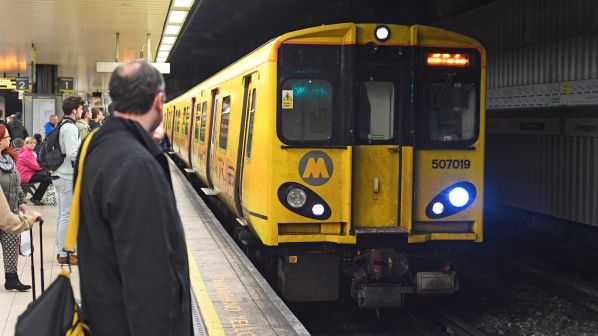TODAY’s Merseyrail commuter network centred on Liverpool is a mishmash of infrastructure built by private railways throughout the middle of the 19th century. New railway tunnels beneath Liverpool city centre, the Mersey River and Birkenhead opened in 1977 binding these routes into a cohesive regional system forming the Wirral and Northern lines, which are now used by more than 100,000 passengers every day.
The result for the modern-day railway is a legacy of limited standardisation, including a wide range of platform heights across the network. This has made accessing Merseyrail’s fleet of 52 three-car class 507 and 508 750V dc third-rail EMUs problematic, even for able-bodied passengers at stations such as Cressington on the Northern Line, where the gap between the train door and the platform is substantial. The problem is further compounded by the fact that 48% of the network’s platforms are curved, resulting in significant gaps and dramatically increasing the chances of accident or injury.
Yet a solution is at hand. From 2020, Merseyrail will begin introducing a new fleet of 36 four-car and seven eight-car class 777 EMUs built by Stadler. Each of the trains will be fitted with an intelligent sliding step, which uses a sensor to detect the location of the platform to provide a 35mm gap by each doorway, guaranteeing accessibility for all passengers.
“This is something a bit novel for us in the UK,” says Mr David Powell, Merseyrail’s programme director for rolling stock, who is leading the train replacement programme. “It changes the game and means that each doorway is responding to the distance from the platform. As we put this package of improvements together, we are going from a position of having an unsatisfactory platform-train interface and a history of things not going quite right there, to something that we think is completely industry-changing.”
To prepare for the introduction of the new trains, infrastructure manager Network Rail (NR) will conduct a series of improvement works beginning this month and concluding in June 2019. Track layouts at 58 stations and 100 platforms will be adjusted across the network, so the current platform train interface range of 60.5cm-102.3cm is reduced to 88cm-94cm, well within NR’s standard requirements.
This work, along with the trains and a new depot at Kirkdale, is part of a £460m investment in the Merseyrail network, the largest since the 1970s. The value rises to £700m when the 30-year maintenance agreement with Stadler is included, while the contract with the manufacturer also includes an option for up to 60 additional vehicles.
Powell says Merseyrail was able to work with Stadler to develop a train to suit its specific needs because Merseytravel, the combined transport authority for the region, decided to buy the trains outright rather than procure them through a leasing company. This would have increased the pressure to buy a standard train that could be deployed elsewhere on the British network, and according to Powell, would have prevented the operator from providing universal access.
The result is that the floor height of the trains is 960mm above the railhead, lower than those usually found in Britain and slightly above a NR standard platform height, which facilitated the development of the intelligent step. This also increases the space available onboard the train. The 64.9m-long and 2.82m-wide class 777s will feature open gangways and accommodate 486 passengers, with 302 standing and 182 seated as well as space for two wheelchair users. The new train features 10 fewer seats than the current class 507/508 sets but will offer an overall 60% increase in capacity. Seats also have a 450mm pitch and more generous leg room while the trains have retained the popular facing arrangement used on the current fleet rather than an airline layout. Passengers will also have access to onboard Wi-Fi and enhanced CCTV will improve security.

Other notable features include a spacious driver’s cab where there is a front emergency escape door, similar to that in use on Berlin U-Bahn vehicles, while a glass wall will enable passengers to see the driver. A warning light system fitted to the doors will accompany the traditional acoustic warning system, with green lights alerting passengers of when it is safe to board the train and red when it is not safe to do so.
“The trains themselves are brighter, wider and have all the common attributes of a 21st century rail vehicle,” says Mr Andy Heath, Merseyrail’s managing director. “It is a step change in terms of the quality of the trains. The 507s and 508s have been in service for 40 years and they are relatively reliable. A lot of the work that has taken place over the last few years on these is cosmetic and it comes to a stage where there is only so much you can do. I think it is indicative of the fact of when these trains are withdrawn, where do they go? I don’t think they will be going anywhere because of their age.”
Heath says the new trains are expected to facilitate an immediate 8% increase in passenger numbers while improved acceleration and deceleration performance will cut journey times by 10% without any increases in line speed.
Stadler announced on September 25 that the first-car bodies are nearing completion in Szolnok, Hungary, and final assembly was set to begin at the end of September in Switzerland. Line testing and certification of the first train will begin on the network in June 2019 and will predominately take place at night on the Kirby branch of the Northern Line. Driver training will begin towards the end of 2019 and the trains will begin to enter service on the Northern and Wirral Lines under the current timetable in February 2020. “The aim is to have all of the trains delivered by early 2021 and then the plan is to implement the new timetable in May 2021,” Heath says.
Merseyrail is supporting the delivery of the trains. However, Heath says it will not benefit financially, with any increases in revenue or savings following their procurement helping to offset Merseytravel’s investment. In addition, the trains have been procured on the precondition that driver-only operation will be introduced.
Heath says a team of 60 onboard staff will provide operations as part of the business case. However, the RMT Union is resisting the changes and is currently in dispute with Merseyrail, resulting in 16 days of industrial action since spring 2017. The union argues that each train should have a second staff member onboard in order to guarantee passenger safety. Heath though believes that metro operation is the right decision.
“80% of our passenger journeys are for people travelling for leisure or work, going from A to B,” Heath says. “They know where they’re going in an urban localised network and that is why it lends itself to no second person. That, together with the driver operating the door, makes that role redundant. Nobody will lose their job, we will redeploy the guard, and they will retain their rate of pay.”
Stadler, which has located its British headquarters in Liverpool, will maintain the trains at a new depot at Kirkdale, which the manufacturer has designed and is currently constructing. The facility’s two maintenance lines will not be electrified. Instead, the trains will use battery power to move in and out of the shed.
As well as these small batteries for slow-speed movements, the sixth train that will be delivered will be fitted with a five-tonne battery in order to conduct line trials to assess the feasibility of extending Merseyrail’s reach beyond the current electrified network. Heath says success here would open up a number of opportunities, including extending Northern Line services from Kirby to Headbolt Lane, and also direct trains to Wrexham using the non-electrified branch from Bidston. “Projects such as Kirby - Headbolt Lane become a lot more attractive when you don’t have the capital cost of the infrastructure,” Heath says. “It enables us to look at network expansions in a new light.”
The Headbolt Lane project is critical to the proposal to open a new line to Skelmersdale, one of the largest towns in England without a railway station. Lancashire County Council is leading the project, allocating £4.32m to develop a business case to build new stations at Kirkby, Rainford and Skelmersdale with Merseytravel contributing £765,000. The project would shift the interchange of electrified Merseyrail and diesel Northern services to Wigan and Manchester from Kirkby to Skelmersdale. And while remaining a long-term project, having the opportunity to run battery trains on the route and not extending third rail will make the estimated £300m scheme more viable, according to Mr Wayne Menzies, Merseytravel’s head of rail.
“We are doing some simulations and we will be doing some real trials when the first units arrive where they will be fitted with different types of battery packs,” Menzies says. “The issue there is how far can they run? You can do all the modelling you like, but until you actually test it, you can’t tell. Also, you have the example if you have a failure of one of those trains, how do you recover it? Do you send another out? And if you can recover it, will it work?”
Menzies adds that the new trains can also support the installation of a pantograph, opening up the opportunity to provide further connections with neighbouring towns and cities in the northwest. Improving such connections falls within the context of the Northern Powerhouse Rail project, which Menzies says foresees a 20-minute Liverpool - Manchester journey time, down from an average of 44 minutes at present (see panel).
Locally, Merseytravel is focusing on the projects identified within its Long-term Rail Strategy, which was issued in 2014 and updated earlier this year.
Menzies says the strategy’s intention was to combine 28 previous policy and strategy plans into a single document to provide some structure and strength to the network development work underway. From this he says it became apparent that Liverpool Central Station is pivotal to rail network development on Merseyside.

The station currently serves 16.5 million passengers per year, with 70% of these using the Northern Line and arriving and departing from a single island platform situated in the centre of the underground station and above the Wirral Line platform which is at the base. However, by the mid-2020s the station will become increasingly difficult to operate due to capacity constraints.
“As well as the morning peak, the problems are prevalent on a Saturday afternoon because we get a real demand spike,” Menzies says. “Increasingly we are in a situation where we are going to have to put operational arrangements in place with Merseyrail to control passenger numbers, and on occasions where we have had significant events, this is exactly what has happened.”
Menzies says Merseytravel is working with NR to find possible solutions to the issue, including widening the existing platform or adding extra platforms as well as the implications for expanding surface entrances and the horizontal and vertical layout of the station. However, this is compounded by proposals for a development alongside the station and land ownership limitations. “There are lots of issues,” Menzies says. “We are working through that with NR and we are also developing a business case to secure some funding for the scheme and starting conversations with the Department for Transport (DfT) as well as looking at what we can do as a combined authority.”
Projects
Menzies says that as a result of the importance of Liverpool Central Station, projects included in the strategy are classified in three areas: those that have been delivered or are underway; projects which are linked to, or require an upgrade at Liverpool Central; and projects that have limited impact on Liverpool Central.
Projects deemed as deliverable and which have since moved ahead include improvements to Newton-le-Willows station, which are due to be completed this month; the new Maghull North station, which opened in June; and the £18.75m Halton Curve project (see below).
As well as Skelmersdale, other long-term projects that would impact Central station include reinstating the Wapping Tunnel to ease pressure on Lime Street station and enable the introduction of Merseyrail services on the City Line; further expansion of Lime Street; establishing a direct rail connection to Liverpool John Lennon Airport; and various electrification schemes. Projects that will not impact Central encompass mainly long-distance service improvements and freight developments.
In addition, there are 25 stations which Merseytravel and its partner authorities are aspiring to develop. Menzies says the authority is going through an assessment process for these stations to decide on how to proceed and to identify the projects which are most likely to secure funding. “What we are trying to do is to find some way that instead of being purely a transport solution, we can look at how we assess the value of a railway station in connection with the rise or regeneration of an area and the economic benefit that it might provide,” he says.
The Long-Term Rail Strategy has facilitated blue sky thinking on the future of the network in the region as well as providing a blueprint for future projects. Indeed, Menzies describes it as an “epiphany moment” for the authority which he says was previously focusing on light rail plans, which would have proved problematic when integrating with heavy rail lines.
The question now, as it always is, is securing the funds to turn many of these projects into reality. Menzies is keen to place this in the context of funds that will be available from both local and national sources. However, he admits that Merseytravel is in the foothills of development work, with firm plans not expected to materialise for at least four to five years.
But with the new trains in service and the battery trials complete by that stage, the authority will have a much clearer idea of what is possible to extend rail’s reach in the region. Merseyrail’s 21st century train could be about to breathe new life into an area boasting some of the world’s earliest railways.
Merseytravel eyes further main line improvements
LIVERPOOL celebrated the reopening of Liverpool Lime Street, the city’s main line hub, in July following an eight-week closure to deliver the second stage of Network Rail’s £140m improvement programme.
Two new platforms have been added while all existing platforms were remodelled, including lengthening and widening of some platforms to accommodate longer trains. Track was renewed and the track layout improved to support greater capacity along with overhead line electrification equipment and signalling infrastructure. Station operations have been transferred to the central Manchester Rail Operating Centre.
The work is facilitating an extra three services in and out of the station every hour, including new direct trains to Scotland.
The Lime Street upgrade was part of a £340m investment by NR in the Liverpool City Region. Other major projects recently completed or underway under the initiative include replacing 1.2km of track on the loop section of the Wirral Line and the 1.6km section under the River Mersey; installation of 1.2km of new track between Huyton and Roby; construction of a new connection between Ditton freight terminal and the 3MG site; resignalling of the 35km section between Weaver Junction and Wavertree Junction (due for completion in May 2019); refurbishment and expansion of Newton-le-Willows station (due for completion this autumn); the addition of a new station at Maghull on the Northern Line; and the Halton Curve project to reinstate a 2.7km link between Frodsham Junction on the North Wales Coast Line and the Liverpool section of the West Coast Main Line, offering a new direct Liverpool - Chester service via Runcorn, which was due to begin in December but has now been delayed until May 2019
The region is also eyeing further rail improvements, particularly with regard to HS2. Menzies points out that Liverpool is the only major northern city without a direct link to the planned high-speed line, with trains from the city joining HS2 at Crewe. However, with Liverpool - Crewe trains only able to operate at a maximum of 93km/h, he says the authority is pushing for a direct high-speed connection to cut future London journey times to 1h 15min, compared with the 1h 36min currently proposed.
In addition, Merseytravel is working with Transport for the North to develop the Northern Powerhouse rail network, which aims to provide fast direct rail connectivity between the major northern English cities of Liverpool, Manchester, Sheffield, Leeds, Newcastle and Hull as well as with Manchester Airport. Menzies says Merseytravel’s preference is for a new Manchester - Liverpool line which would achieve a 20-minute journey time between the major cities and also provides a direct link to HS2.
The Merseyrail network
CONSISTING of 120.7 route-km and 68 stations, the Merseyrail network centred on Liverpool currently carries more than 114,000 passengers every day.
Services are operated by Merseyrail, a 50-50 joint venture of Abellio and Serco, which was awarded a 25-year concession by regional transport authority, Merseytravel, in 2003. The concession is reviewed every five years.
Services encompass the Northern Line, which runs on three main routes from Hunts Cross in the south of Liverpool to Southport via the Link tunnel from Brunswick Station through central Liverpool; from Liverpool Central to Ormskirk; and from Liverpool Central to Kirkby; and the Wirral Line, which runs from termini at Chester, Ellesmere Port, New Brighton and West Kirby to Hamilton Square station in Birkenhead. From here the line proceeds through the Mersey Railway Tunnel, continuing in the single-track loop tunnel under Liverpool city centre, and returning to the Wirral’s termini.
Merseyrail is also responsible for the City Line. These electric services are operated by franchisee Northern, and radiate east from Liverpool Lime Street Station to Manchester, Wigan and Crewe. The service covers much of the world’s first railway line which opened between Liverpool and Manchester in 1830.

